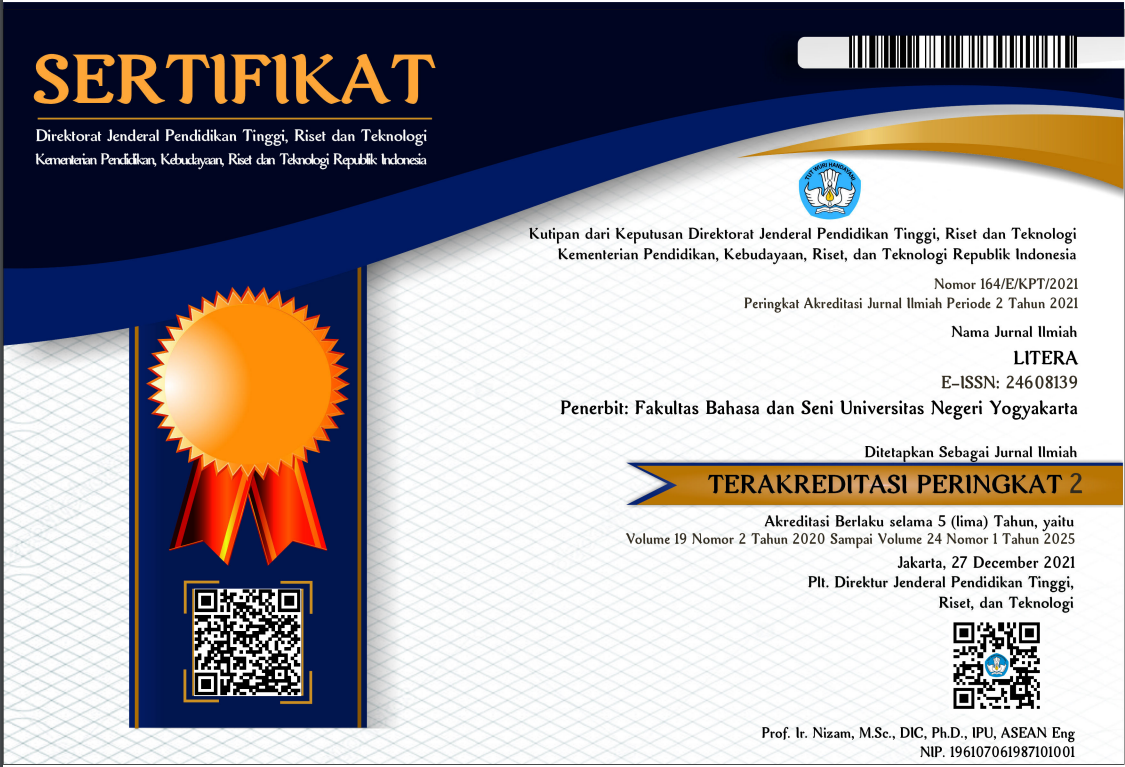Revealing students’ social-emotional competence of the English education department
Downloads
Beyond equipping pedagogical competence, English Education students are increasingly expected to navigate diverse classroom environments, cultivating social and emotional competence (SEC) to confront cultural sensitivity in today’s 21st century. SEC is crucial for pre-service teachers as they prepare to educate future generations. Although extensive research has been carried out on SEC in foreign language learners, no study portrays English Education students’ SEC across programs. Through a quantitative survey research design, this study investigates the perceived levels of English Education students’ SEC and measures to what extent their levels vary according to their gender and education levels. A questionnaire survey of the social-emotional foreign language learning scale (SEFLLS) was distributed to the participants. Descriptive analyses (mean, standard deviation) and inferential statistics (Mann-Whitney U test) were conducted to analyze the data. The significant findings highlighted that English education students have high levels of overall social-emotional competence in both programs. Besides, findings indicated no significant difference based on participants’ gender in their SEC and dimensions. Similarly, no significant differences were found between participants’ education levels regarding their self-regulation and social relations. Yet, a significant difference was detected in the decision-making dimension and overall SEC. Subsequent studies could examine SEC factors across different cultures or socioeconomic levels in the context of language learning.
Downloads
Albantani, A. M., & Madkur, A. (2018). Think globally, act locally: The strategy of incorporating local wisdom in foreign language teaching in Indonesia. International Journal of Applied Linguistics and English Literature, 7(2), 1. https://doi.org/10.7575/aiac.ijalel.v.7n.2p.1
Anisa, L., Suganda, L. A., & Jaya, H. P. (2019). Indonesian English teachers’ social-emotional competence and students’ English learning motivation. Indonesian Journal of English Language Teaching and Applied Linguistics (IJELTAL), 4(1), 83. https://doi.org/10.21093/ijeltal.v4i1.320
Anuyahong, B., Songakul, K., & Rattanapong, C. (2024). Analyzing the role of culture in TEFL pedagogy and its implications for language teaching. International Journal of English Language Teaching, 12(4), 40-56. https://doi.org/10.37745/ijelt.13/vol12n44056
Artino, A. R., & Stephens, J. M. (2009). Academic motivation and self-regulation: A comparative analysis of undergraduate and Graduate Students Learning Online. The Internet and Higher Education, 12(3–4), 146–151. https://doi.org/10.1016/j.iheduc.2009.02.001
Bashir, A., Amir, A., & Bajwa, K. M. (2019). An investigation of stressors among university students: A qualitative approach. UCP Management Review, 3 (1), 5–24
Buttjes, D. (1990). Teaching foreign language and culture: Social impact and political significance. Language Teaching Journal, 2, 53-57
Byram, M. (1997). Teaching and assessing intercultural communicative competence. Multilingual Matters
Çelik, S., & Erbay Çetinkaya, Ş. (2022). Social-emotional learning competencies of Turkish learners of English:A psychometric evaluation. Educational Academic Research, 1(45), 71-82. 10.54614/AUJKKEF.2022.992998
Chaplin, T., & Aldao, A. (2013). Gender differences in emotion expression in children. Psychological Bulletin 139, 735 Historical Perspective. Infants & Young Children, (23), 73–83
Chernyshenko, O. S., Kankaraš, M., & Drasgow, F. (2018). Social and emotional skills for student success and well-being: Conceptual framework for the OECD study on social and emotional skills. OECD Education Working Papers, 173, 1–136. https://doi.org/10.1787/db1d8e59-en
Collaborative for Academic, Social, and Emotional Learning (CASEL). (2022). What is social and emotional learning? CASEL District Resource Centre. https://drc.casel.org/what-is-sel/
Curby, T. W., Brown, C. A., Bassett, H. H., & Denham, S. A. (2015). Associations between preschoolers’ social–emotional competence and preliteracy skills. Infant and Child Development, 24(5), 549– 570
Deardorff, D. K. (2006). Identification and assessment of intercultural competence as a student outcome of internationalization. Journal of Studies in International Education, 10, 241-266. https://doi.org/10.1177/1028315306287002
DeLay, D., Zhang, L., Hanish, L. D., Miller, C. F., Fabes, R. A., Martin, C. L., Kochel, K. P., & Updegraff, K. A. (2016). Peer influence on academic performance: A social network analysis of social-emotional intervention effects. Prevention Science, 17(8), 903–913. https://doi.org/10.1007/s11121-016-0678-8
Destin, M., Rosario, R. J., & Vossoughi, S. (2021). Elevating the objectives of higher education to effectively serve students from diverse socioeconomic backgrounds. Policy Insights From the Behavioral and Brain Sciences, 8(1), 59–66. https://doi.org/10.1177/2372732220980766
Durlak, J. A., Domitrovich, C. E., Weissberg, R. P., & Gulotta, T. P. (2015). Handbook of social and emotional learning: Research and practice (1st ed.). Guilford Publications
Durlak, J. A., Weissberg, R. P., Dymnicki, A. B., Taylor, R. D., &Schellinger, K. B. (2011). The impact of enhancing students’ social and emotional learning: A meta-analysis of school-based universal interventions. Child Development. 82, 405–432. https://doi.org/10.1111/j.1467-8624.2010.01564.x
Elias, M. J., & Haynes, N. M. (2008). Social competence, social support, and academic achievement in minority, low-income, urban elementary school children. School Psychology Quarterly, 23(4), 474–495. https://doi.org/10.1037/1045-3830.23.4.474
Fraenkel, J. R., & Wallen, N. E. (2006). How to design and evaluate research in education. McGrawall Hill
Gardner, R. C. (1985). Social psychology and second language learning: The role of attitudes and motivation. Edward Arnold Publishers
Garner, P. W., Mahatmya, D., Brown, E. L., & Vesely, C. K. (2014). Promoting desirable outcomes among culturally and ethnically diverse children in social emotional learning programs: A multilevel heuristic model. Educational Psychology Review, 26(1), 165–189
Gilar-Corbí, R., Pozo-Rico, T., Sánchez, B., & Castejón, J. L. (2018). Can emotional competence be taught in higher education? A randomized experimental study of an emotional intelligence training program using a multimethodological approach. Frontiers in Psychology, 9. https://doi.org/10.3389/fpsyg.2018.01039
Gresham, F., Elliott, S., Metallo, S., Byrd, S., Wilson, E., Erickson, M., Cassidy, K., & Altman, R. (2020). Psychometric fundamentals of the social skills improvement system: Social–emotional learning edition rating forms. Assessment for Efective Intervention, 45(3), 194–209. https:// doi.org/10.1177/1534508418808598
Guzmán, E., Baeza, C. G., & Morales, M. (2023). Vivencias académicas y salud mental en tres cohortes universitarias bajo emergencia COVID-19. Revista Latinoamericana de Ciencias Sociales, Niñez y Juventud, 21(2), 1–22. https://doi.org/10.11600/ rlcsnj.21.2.5841
Hashemi, M. (2011). Language stress and anxiety among the English language learners. Procedia - Social and Behavioral Sciences, 30, 1811–1816. https://doi. org/10.1016/j.sbspro.2011.10.349
Hermana, P., Zuraida, Z., & Suganda, L. A. (2021). Indonesian pre-service teachers’ mindfulness, social emotional competence, and academic achievement. International Journal of Evaluation and Research in Education (IJERE), 10(4), 1176. https://doi.org/10.11591/ijere.v10i4.21272
Hecht, M. L., & Shin, Y. (2015). Culture and social and emotional competencies. In J. A. Durlak, C. E. Domitrovich, R. P. Weissberg, & T. P. Gullotta (Eds.), Handbook of social and emotional learning: Research and practice (pp. 50–64). The Guilford Press
Horwitz, E. K., Horwitz, M. B., & Cope, J. (1986). Foreign language classroom anxiety. The Modern Language Journal, 70(2), 125–132. https://doi.org/ 10.1111/j.1540-4781.1986.tb05256.x
Hyde, J. S. (2005). The gender similarities hypothesis. American Psychologist, 60(6), 581–592. https://doi.org/10.1037/0003-066x.60.6.581
Illovsky, M. E. (2010). Psychological comparisons of undergraduate and graduate college of education students. International Journal of Teaching and Learning in Higher Education, 22(3). 238-245
Kramsch, C. (1993). Context and culture in language teaching. Oxford University Press
Körkkö, M., & Lutovac, S. (2024). Relational perplexities of today’s teachers: Social-emotional competence perspective. Teaching Education, 1–17. https://doi.org/10.1080/10476210.2023.2298194
Kramsch, C. J. (1998). Language and culture. Oxford University Press
Martin, A. J., & Collie, R. J. (2016). The role of teacher-student relationships in unlocking students’ academic potential: Exploring motivation, engagement, resilience, adaptability, goals, and instruction. In Handbook of social influences on social-emotional, motivation, and cognitive outcomes in school contexts, 0-34. Routledge
Martinez-Yarza, N., Santibáñez, R., & Solabarrieta, J. (2023). A systematic review of instruments measuring social and emotional skills in school-aged children and adolescents. Child Indicators Research, 16(4), 1475–1502. https://doi.org/10.1007/s12187-023-10031-3
Meshkat, M., & Nejati, R. (2017). Does emotional intelligence depend on gender? A study on undergraduate English majors of three Iranian universities. SAGE Open, 7(3), 215824401772579. https://doi.org/10.1177/2158244017725796
Mohammed, M. A. A. (2020). The impact of culture on English language learning. International Journal on Studies in English Language and Literature (IJSELL), 8(1), 21-27. https://doi.org/10.20431/2347-3134.0801003
Pancorbo, G., Primi, R., John, O. P., Santos, D., Abrahams, L., & De Fruyt, F. (2020). Development and psychometric properties of rubrics for assessing social-emotional skills in youth. Studies in Educational Evaluation, 67(100938), 1-14. https://doi.org/10.1016/j.stueduc.2020.100938
Park, J., Haddon, A., & Goodman, H. (2003). The emotional literacy handbook: Processes, practices and resources to promote emotional literacy. David Fulton
Portela-Pino, I., Alvariñas-Villaverde, M., & Pino-Juste, M. (2021). Socio-emotional skills in adolescence. Infuence of personal and extracurricular variables. International Journal of Environmental Research and Public Health, 18(9). https://doi.org/10.3390/ijerph18094811
Purwanti, I. Y., Wangid, M. N., & Pratiwi, C. (2022). Academic Self Awareness, self-regulation and academic burnout among college students. Advances in Social Science, Education and Humanities Research. https://doi.org/10.2991/assehr.k.220405.021
Salovey, P., & Mayer, J. D. (1990). Emotional intelligence. Imagination, cognition and personality, 9(3), 185–211
Schonert-Reichl, K. A., Kitil, M. J., & Hanson-Peterson, J. (2017). To reach the students, teach the teachers: A national scan of teacher preparation and social and emotional learning. A report prepared for the Collaborative for Academic, Social, and Emotional Learning (CASEL). University of British Columbia Retrieved from https://eric.ed.gov/?id=ED582029
Shrestha, K. N. (2016). Role of (local) culture in English language teaching. Journal of NELTA, 21(1–2), 54–60. https://doi.org/10.3126/nelta.v21i1-2.20201
Simion, A. (2023). The impact of socio-emotional learning (SEL) on academic evaluation in higher education. Educatia 21, (24), 109–117. https://doi.org/10.24193/ed21.2023.24.11
Sudartini, S. (2012). Inserting local culture in English language teaching to promote character education. Journal Pendidikan Karakter, 2 (1), 45-54
Taylor, S. N., & Hood, J. N. (2010). It may not be what you think: Gender differences in predicting emotional and social competence. Human Relations, 64(5), 627–652. https://doi.org/10.1177/0018726710387950
Tolan, P., Ross, K., Arkin, N., Godine, N., & Clark, E. (2016). Toward an integrated approach to positive development: Implications for intervention. Applied Developmental Science, 20(3), 214–236. https://doi.org/10.1080/10888691.2016.1146080
Ummah, R., & Fitriasari, B. (2020). Is it different (?): The socio-emotional competence of the Javanese children based on gender. In Proceedings of the 5th ASEAN Conference on Psychology, Counselling, and Humanities (ACPCH 2019), 395, 129-131. https://doi.org/10.2991/assehr.k.200120.028
Wang, C., Hatzigianni, M., Shahaeian, A., Murray, E., & Harrison, L. J. (2016). The combined effects of teacher-child and peer relationships on children’s social-emotional adjustment. Journal of School Psychology, 59, 1–11. https://doi.org/10.1016/j.jsp.2016.09.003
Wang, J., Chen, Y., Chen, H., Hua, L., Wang, J., Jin, Y., He, L., Chen, Y., & Yao, Y. (2023). The mediating role of coping strategies between depression and social support and the moderating effect of the parent–child relationship in college students returning to school: During the period of the regular prevention and control of COVID-19. Frontiers in Psychology, 14. https://doi.org/10.3389/fpsyg.2023.991033
Wang, Y., Yang, Z., Zhang, Y., Wang, F., Liu, T., & Xin, T. (2019). The effect of social-emotional competency on child development in western China. Frontiers in Psychology, 10(1282), 1-10. https://doi.org/10.3389/fpsyg.2019.01282
Wirajaya, G., Suganda, L. A., & Zuraida, Z. (2019). Indonesian students’ social-emotional competencies and their English academic achievement. Journal of Education and Learning (EduLearn), 13(2), 163–169. https://doi.org/10.11591/edulearn.v13i2.12160
Zaimoğlu, S., & Sahinkarakas, S. (2021). Development of a social-emotional foreign language learning scale (SEFLLS) for Young Adults. Current Psychology, 42(9), 7501–7511. https://doi.org/10.1007/s12144- 021-02090-y
Zhang, C., Mao, L., Li, N., & Gu, X. (2022). Chinese EFL students’ social-emotional competence, grit, and academic engagement. Frontiers in Psychology, 13. https://doi.org/10.3389/fpsyg.2022.914759
Zhou, M., and Ee, J. (2012). Development and validation of social-emotional competency questionnaire. Int. J. Emot. Educ. 4, 27–42
Zins, J. E., Bloodworth, M. R., Weissberg, R. P., & Walberg, H. J. (2007). The scientific base linking social and emotional learning to school success. Journal of Educational and Psychological Consultation, 17(2-3), 191–210. 10.1080/1047441070141 3145
Copyright (c) 2025 Muhamad Laudy Armanda, Agus Widyantoro

This work is licensed under a Creative Commons Attribution-ShareAlike 4.0 International License.

This work is licensed under a Creative Commons Attribution-ShareAlike 4.0 International License.























